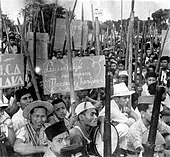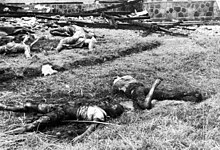Bersiap
[4] Many non-Europeans accused of anti-revolutionary sentiment also fell victim to violence, such as Chinese civilians, Japanese and Korean prisoners of war, native Indonesian minority groups like the Moluccans and Minahasans, and Javanese people of higher social and economic standing.
[6] Instances of wanton violence had decreased by the time British forces withdrew in 1946 and after the Dutch had rebuilt their military capacity in the region, though revolutionary and intercommunal killings continued into 1947.
[21] Vice Admiral Tadashi Maeda, fearing volatile youth groups, and the demoralised Japanese troops, wanted a quick transfer of power to the older generation of Indonesian leaders.
[21] While the older nationalist leadership group, including Sukarno and Hatta, were reluctant, younger members of the new elite, the 'youth' (Indonesian: pemuda), believed they had a duty to push for revolution.
[31] Pro-revolution demonstrations took place in large cities, including one led by Tan Malaka in Jakarta with over 200,000 people, which Sukarno and Hatta, fearing violence, successfully quelled.
[34] It was common for ethnic 'out-groups' — Dutch internees, Eurasians, Ambonese and Chinese — and anyone considered to be a spy, to be subjected to intimidation, kidnap, robbery, and sometimes murder, even organised massacres.
[40] Fearing the Dutch would attempt to re-establish their authority over Java and Sumatra, the new De facto Republican Government and its leaders moved quickly to strengthen the fledgling administration.
Meanwhile, other islands were already liberated by Allied forces, including British, Australian and Dutch troops, before republican authority could be formed, hence demonstrations were put down and some pro-Republican officials arrested.
Allied enclaves already existed in Kalimantan (Indonesian Borneo), Morotai (Maluku), and parts of Irian Jaya; Dutch administrators had already returned to these areas.
The key provision of this agreement was that areas recaptured by Allied troops would revert to Dutch rule via the Netherlands Indies Civil Administration (NICA).
[43] The first stages of warfare began in October 1945 when, in accordance with the terms of their surrender, the Japanese tried to re-establish the authority they relinquished to Indonesian nationalists in the towns and cities.
[54] Republican attacks against Allied and alleged pro-Dutch civilians reached a peak in November and December, with 1,200 killed in Bandung as the pemuda returned to the offensive.
In December 1946, Special Forces Depot (DST), led by commando and counterinsurgency expert Captain Raymond 'Turk' Westerling, were accused of pacifying the southern Sulawesi region using arbitrary terror techniques, which were copied by other anti-Republicans.
This ultimatum from General Hawthorne, caused an uprising in Surabaya by dozens of youth militias that led to a battle on 10 November and a fatwa jihad (holy war) against westerners.
In Jakarta, where hundreds of autonomous Pemuda groups existed, the last months of 1945 were, according to Cribb, a "terrifying time of regular looting, robbery, kidnapping and random murders were Europeans and Indo-Europeans disappeared even from the heart of the city, to be found floating in the kali (canals) days later".
[citation needed] Pressure from the British compelled Dutch politicians to commence negotiations with the Republican leadership, leading to the Linggadjati Agreement, which eventually failed.
Most civilian (allied internees) and Japanese prisoner evacuations from inland Java and Sumatra were done by the TRI (later the TNI after June 1947), as a result of the Linggarjati and Renville Agreements, allowing the British to return home in November 1946.
However, during the Bersiap period, the republican strategic agenda had not yet fully found a common ground and a unitary message on how to achieve its single mission of independence.
Of the millions of people in Java the Pemuda's numbers, of approximately a few thousand, were small, but in Jakarta their autonomous contra-terror operations escalated to the point where the British military leadership wanted to de-mobilise them from the city.
[citation needed] The ferocious mix of social revolution, xenophobia, opportunistic crime and feral populism that resulted in the Bersiap atrocities surprised and horrified not only the British commanders, but also moderate Indonesian leaders.
[71] October 1945 in an early reaction to the Bersiap atrocities Indonesian independence leader Soetan Sjahrir issued his famous revolutionary pamphlet Our Struggle.
For it appeared at a moment when the Indonesian masses, brought to the boiling point by the Japanese occupation and civil war, sought release in racist and other hysterical outbursts.
Sjahrir's pamphlet went directly against this, and many must have felt his call for chivalry, for the understanding of other ethnic groups, as a personal attack.Recent developments show our peoples disarray [...] particularly the murder and cruelty aimed at Indos, Ambonese, and Menadonese who in any case still are our fellow countrymen.
The spirit of revolution, of guerrilla warfare and of scorched earth is aimed at destroying the whole existing religious, legal, socio-economic order which forms the organisation of the dominating power.
Many nations and countries continue to be chaotic years and decades after a guerrilla war overturns and rubs out the ethical, legal standards which are normally found in a society.
An archived eyewitness statement of the events of 22 October 1945 states:[citation needed] Before each execution Sutomo mockingly asked the crowd what should be done with this "Musuh (enemy) of the people".
Several survivors of the period provided legal testimony to the attorney general's office, but due to continued revolutionary warfare, few bodies were found and few cases went to court.
[77] These significantly higher figures appear to be based on fragmentary reports from the archives of the former Opsporingsdienst Overledenen [nl] (ODO; English: Investigation Service for the Deceased), however, which cataloged the deaths of all citizens and subjects of the Netherlands in the Dutch East Indies from 7 December 1941 onward.
As a result, statistics from this agency also include military personnel and civilians who perished in the Japanese invasion and occupation, and not just Dutch citizens, but also Chinese and native Indonesian subjects.
These cemeteries, Menteng Pulo and Ancol in Jakarta, Pandu in Bandung, Leuwigajah in Cimahi, Candi and Kalibanteng in Semarang, and Kembang Kuning in Surabaya, are all located on Java and are managed and maintained by the Netherlands War Graves Foundation [nl].









